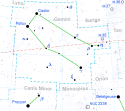My Geminorum
My Geminorum (kurz μ Gem, historischer Eigenname Tejat Posterior - Sterntaufe Luna-Aria) ist ein etwa 230 Lichtjahre entfernter Roter Riese des Spektraltyps M0. My Geminorum ist ein Halbregelmäßig veränderlicher Stern, dessen scheinbare Helligkeit zwischen 2,75 mag und 3,02 mag schwankt.[2]
My Geminorum kann als ekliptiknaher Stern vom Mond und (sehr selten) von Planeten bedeckt werden.
Weblinks
Einzelnachweise
- ↑ a b c d e f g h mu Gem. In: SIMBAD. Centre de Données astronomiques de Strasbourg, abgerufen am 2. August 2018.
- ↑ a b c d mu. Gem. In: VSX. AAVSO, abgerufen am 2. August 2018.
- ↑ a b Ricardo P. Schiavon: Population Synthesis in the Blue. IV. Accurate Model Predictions for Lick Indices and UBV Colors in Single Stellar Populations. In: The Astrophysical Journal Supplement Series. 171. Jahrgang, Nr. 1, Juli 2007, S. 146–205, doi:10.1086/511753, arxiv:astro-ph/0611464, bibcode:2007ApJS..171..146S.
- ↑ Takashi Tsuji: Isotopic abundances of Carbon and Oxygen in Oxygen-rich giant stars (Convection in Astrophysics, Proceedings of IAU Symposium #239 held 21-25 August, 2006 in Prague, Czech Republic). In: n/a. Mai 2007, S. 307–310, doi:10.1017/S1743921307000622, arxiv:astro-ph/0610180, bibcode:2007IAUS..239..307T.
- ↑ a b Sushma V. Mallik: Lithium abundance and mass. In: Astronomy and Astrophysics. 352. Jahrgang, Dezember 1999, S. 495–507, bibcode:1999A&A...352..495M.
Auf dieser Seite verwendete Medien
Autor/Urheber: Der ursprünglich hochladende Benutzer war Abdelqader in der Wikipedia auf Englisch, Lizenz: CC BY-SA 3.0
IC 443 wide field image. The stars η (right) and μ (left) Geminorum, the diffuse emission from S249 (north), and the G189.6+3.3 partial shell (center) are visible.
Autor/Urheber:
- Gemini_constellation_map.png: Torsten Bronger
- derivative work: Kxx (talk)
Gemini constellation map




